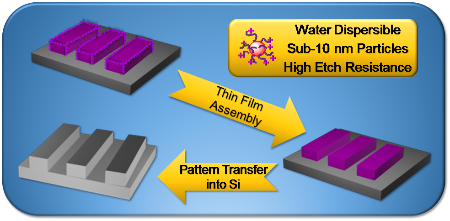Mr Zhen Jiang has as part of his PhD studies developed new aqueous-soluble molecules for healing of LER, an important problem for the microelectronics industry.
Healing surface roughness of lithographic nanopatterns through sub-10 nm aqueous-dispersible polymeric particles with excellent dry etch durability

The surface roughness in patterned features, commonly termed line-edge roughness (LER), is of particular concern in the manufacture of advanced micro-electronics devices. To address this challenge, we describe an approach whereby the block copolymer poly(oligoethyleneglycol methyl ether methacrylate-stat-styrene)-b-P(N-[3-(dimethylamino)propyl]methacrylamide) (poly(OEGMA-stat-styrene)-b-PDMAPMA) is applied to the patterned photoresist, and after thermal annealing reduces significantly the nanoscale surface roughness. The incorporation of hydrophilic OEGMA units enabled the block polymer to be readily dispersed in water and to self-assemble into particles of less than 10 nm in diameter. Importantly, as a result of the incorporation of a relatively high content of the monomer styrene, excellent plasma etch durability was achieved. The relatively low glass transition temperature of the block copolymer allows thermal annealing at temperatures well below the Tg of the photoresist, enabling effective reduction in LER with minimal change to the profiles of the resist sidewalls and trenches. Partial healing of roughness in lithographic patterns with critical dimensions as low as 25 nm was demonstrated. Finally the relatively high aromatic content of the block copolymer allowed the smoothed patterns to be successfully transferred into the underlying silicon wafer.
